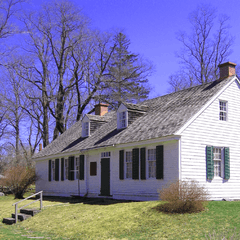Simeon Perkins

Colonel Simeon Perkins was born in Norwich, Connecticut, one of sixteen children of Jacob Perkins and Jemima Leonard. He came to Liverpool, Nova Scotia, in May 1762 as part of the New England Planter migration to Nova Scotia.[1] In Liverpool, Perkins immediately began trading in fish and lumber and forged trading ties with New England, Newfoundland, Europe and the West Indies.
During the American Revolution, Perkins was at first neutral, but became increasingly loyal to the British cause. His diary, which he began in 1766, remains a vital source for historians studying colonial Canada and the battle for identity and loyalty. After relentless American privateer attacks on shipping and an attempted American looting of Liverpool itself, Perkins led the outfitting of several privateer ships against the Americans.[2] Perkins also invested in privateering during the Napoleonic Wars, earning substantial returns from vessels such as the ships Charles Mary Wentworth, Duke of Kent and the famous brig Rover[3]
A born leader, he held public office for a long period representing Queens County in the Nova Scotia House of Assembly from 1765 to 1768 and from 1770 to 1799.[4] He held twenty-seven government positions in his lifetime, none of which paid, including justice of the peace, colonel of the militia, and judge in the Inferior Court of Common Pleas and the Court of Quarter Sessions.[4]
He had nine children from two marriages. His first wife, Abigail Backus, died four weeks after the birth of his first son Roger. He married again in 1775 to Mrs. Elizabeth Headley (Young) who had been widowed two months before the birth of her daughter Ruth.
One of his diary entries, for October 12, 1786 allegedly contains the first report of a UFO sighting in modern North America.[5] Perkins reports the tale circulating at the time of a young lady and two men living on the shores of the Bay of Fundy, who, during a recent sunrise, saw as many as fifteen “ships in the air ... and a man forward with his hand stretched out.” Perkins continues, "the story did not obtain universal credit but some people believed it."
Perkins House Museum
Perkins' home in Liverpool, Nova Scotia is open to the public and guided tours are given from June until October. It was purchased by the Province of Nova Scotia and opened as part of the Nova Scotia Museum system at the suggestion of the author Thomas Raddall who lived in Liverpool.[6]
Further reading
- Early Liverpool and its Diarist by C. Bruce Fergusson (1963).
- The Diary of Simeon Perkins (5 volumes), edited by Harold A. Innis et al., published by The Champlain Society (1947–78).
- The Boston Tea Party and the American Revolution: Excerpts from Simeon Perkins' Diary (1774-1782) Queens County Museum (1992).
References
- ↑ Converse, Charles Allen (1905). Some of the Ancestors and Descendants of Samuel Converse, Jr., Vol. II, pp. 833-34. Boston: Eben Putnam.
- ↑ Horwood, Harold and Butts, Ed (1988). Bandits and Privateers: Canada in the Age of Gunpowder, p. 49. Halifax, Nova Scotia: Formac Publishing Company. ISBN 0-88780-157-9.
- ↑ Conlin, Daniel. "A Private War in the Caribbean: Nova Scotian Privateering 1793-1805, The Northern Mariner, Vol. VI, No. 4, p. 29-48.
- ↑ 4.0 4.1 Fergusson, C Bruce (1983). "Simeon Perkins". Dictionary of Canadian Biography Online. Retrieved 2008-09-30.
- ↑ Mark Kearney and Randy Ray, The Great Canadian Trivia Book, 1996, page 183
- ↑ "Thomas Raddall Selected Correspondence: An Electronic Edition"
External links
- Biography at the Dictionary of Canadian Biography Online
- Perkins House Museum
- Excerpts from his diary
- Index of Genealogical Extracts From Simeon Perkins' Diary
- Canadian Register of Historic Places Listing
|